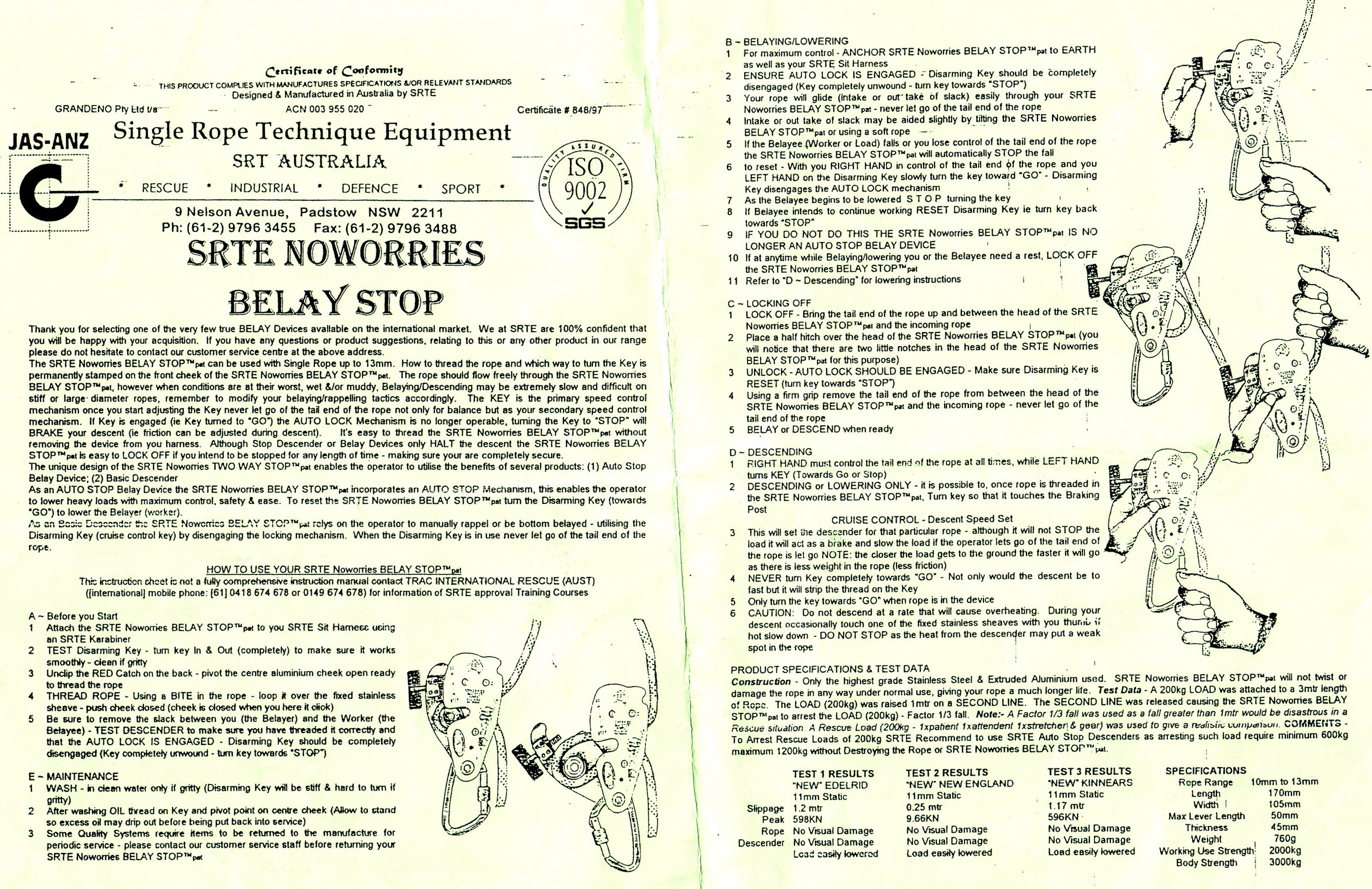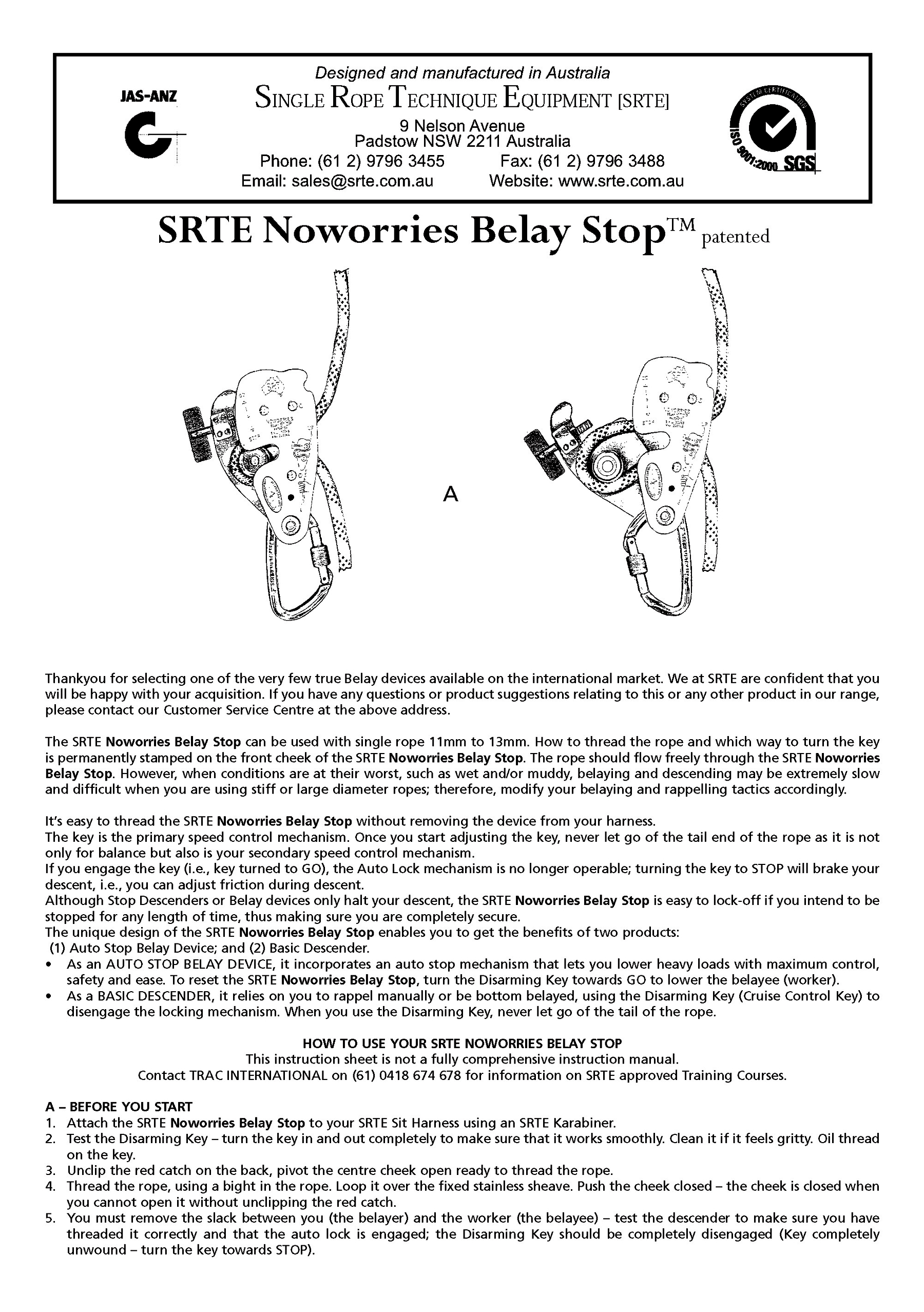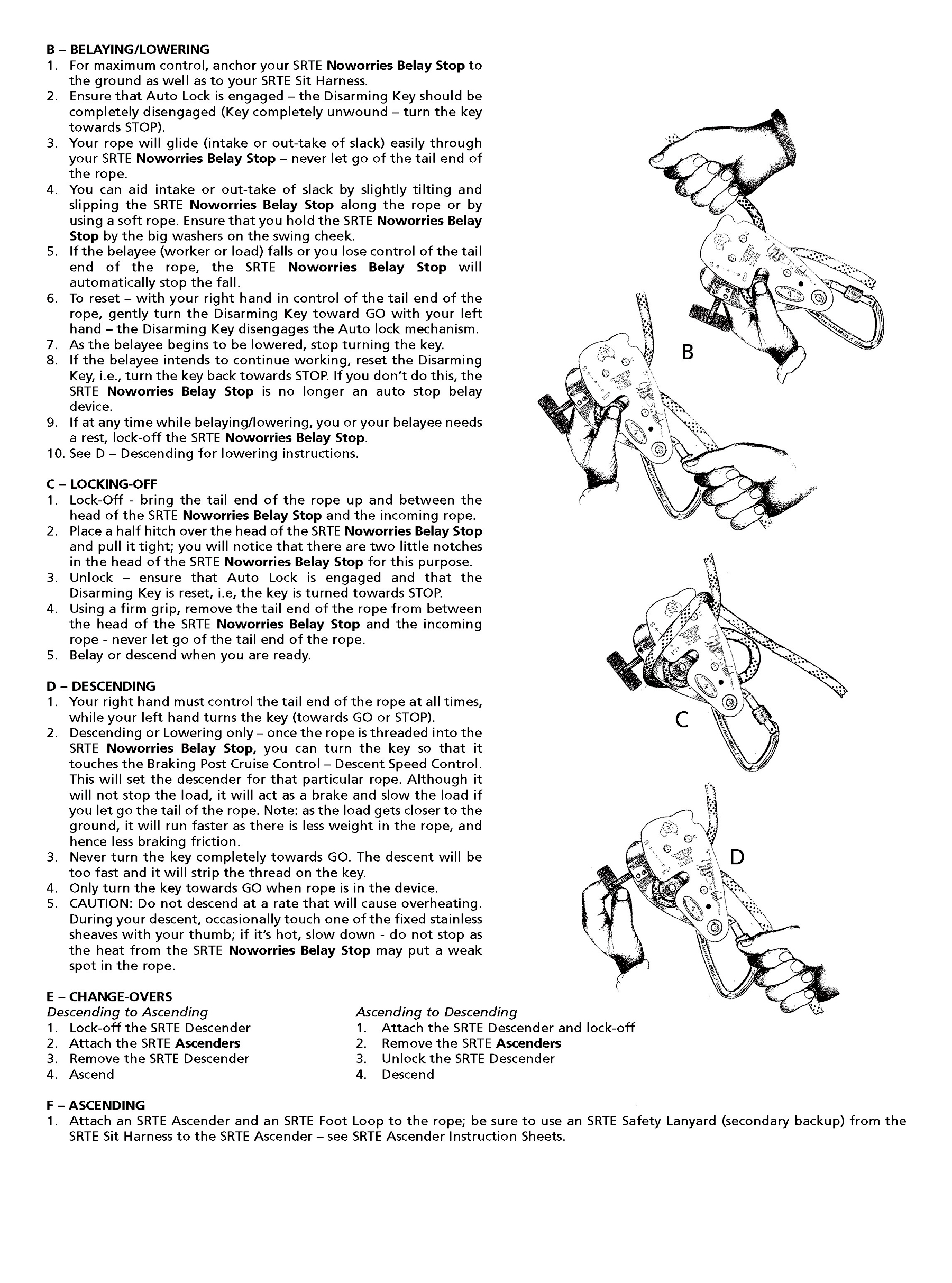Technical Details
I acquired my Belay Stop from Single Rope Technique Equipment in October
1999.
The Belay Stop consists of three bollards. The top and bottom
bollard are mounted between two fixed plates, while the third
is mounted on swinging plate. The pivot that serves as an attachment
post. An adjustment screw assembly helps vary the friction in
the device.
Each fixed plate is an irregular piece of gold anodized 4 mm
aluminum. The plates are 167 mm. high with curved top and
sides. The top half of each plate is about 67 mm. wide at
the top, increases to 79 mm. about 50 mm. down, then
the plates taper to join a 17 mm. diameter circular arc at
the bottom. Both plates have a shallow notch at the top right
(facing the front of the device) to help hold the rope while tying
off. The rear plate has two smaller plates attached to house a
spring-loaded catch. The fixed plates are attached to a 13 mm.
diameter steel attachment post at the center of the bottom circular
arc. The fixed plates are rigidly riveted to the post. The top
and bottom rope bollards are also riveted between the fixed plates. There
is also a flattened 11.5 mm. steel bar riveted between the
plates at the level of the top bollard. The inside separation
of the front and rear plates is about 21 mm.
An irregular swinging plate is hinged to the attachment post.
The middle bollard is mounted on this plate. The rivet is extended
on the rear side of the swinging plate so that the spring-loaded
catch can engage and keep the device closed. The end of the catch
spring tends to open the swinging plate. Each end of this rivet
has a washer that extends over the sides of the corresponding
notches in the fixed plates. A small aluminum block is bolted
to the upper left inside of the plate. A 9.5 mm. threaded
rod (with about 7 left-hand threads per centimeter) passes through
this plate and presses against the fixed bar. A cross piece is
pinned to the other end of the rod, making it much like a wing
nut. Mine is red, indicating that it is designed for ropes up
to 12 mm. in diameter.
The bollards are made of stainless steel. The bollards are
riveted to the appropriate plate and pinned so they cannot rotate.
Each rope bollard has a groove that fits into a corresponding
notch in the appropriate plate (i.e., the fixed bollards have
a notch to clear the swinging plate and vice versa). The bollards
are 16 mm. wide, excluding the notch. All three bollards
appear to be identical. The bollard diameter is 28 mm. in
the center, and widens to 32 mm. about 1 mm. from the
edge, then remains constant. The three bollards are mounted 112 mm.,
72 mm. and 47 mm. from the center of the pivot point.
When the rope is inserted, this asymmetrical arrangement ensures
that the rope is pinched between the center and bottom bollards
only.
The front piece is covered with stampings, including
- The Single Rope Technique Equipment logo (SRT inside an outline of
Australia)
- A double arrow with "GO" and "STOP to indicate
which way to turn the adjustment screw
- NOWORRIES
BELAY STOP
PATENTED
S.W.L. 300KG
MAX 2000KG
- An illustration showing how to rig the device and the word
"UP"
- A serial number (19815201)
The safety catch has an arrow and the word "OPEN"
to assist the intellectually challenged.
 Like all Single Rope Technique Equipment, the Belay Stop is
well made, rugged, strong, and a bit heavy.
Like all Single Rope Technique Equipment, the Belay Stop is
well made, rugged, strong, and a bit heavy.
The red key indicates that my Belay Stop was designed for ropes
up to 12 mm. in diameter. There is a green key version for
larger ropes. I assume that there is some more significant difference
than the color of the wing nut (perhaps the length of the rod, but more likely, the diameter of the middle bollard, as on the Two Way Stop versions),
although I don't see any immediate reason why mine wouldn't work
on 13 mm. rope (except using a rope that large caving or
climbing would be absurd). I haven't had the chance to thoroughly
test the Belay Stop, so I can't say how it performs with different
ropes and under various conditions of mud and water. What I have
tested is its performance on clean, dry 11 mm. PMI pit rope,
a rather stiff caving rope, on short drops. In these limited tests
it has performed very well. When the rod is unscrewed, there is
enough friction to hold me in place. As the rod is tightened,
the friction is gradually reduced. The transition is slow enough
that it is easy to maintain control with the braking hand. The
rod turns easily, without any sensation of having to force it.
This was to be expected - but only because I tried the Troll
(USA) Alp first.
Getting used to the left-hand thread was easy because I’d already
gotten used to the Troll (USA)
Alp, which works the same way. Both devices are designed for
the traditional right-handed user who brakes with their right
hand at the right hip. Although I'm right-handed, I prefer to
brake left-handed, so I’d rather have a mirror-image version,
although this hardly is significant enough to be worth worrying
about.
One should understand that part of the friction is obtained
by squeezing the rope between the center and bottom bollard. As
one turns the rod counter-clockwise, it forces the swinging plate
in the direction that separates the center and lower bollard,
reducing the rope squeezing action. The friction decreases accordingly.
This process only continues until there is no more squeezing.
After that, there is very little change in friction. This is rather
obvious, because there is no large change in the snubbing angle
once the bollards are separated. The practical effect is that
if one starts a rappel with the rod screwed in and finds out that
the friction is insufficient, it will take many turns before the
friction is significantly increased. One should always start with
the rod unscrewed as far as practicable for the conditions.
The instruction sheet shows how to use the Belay Stop for belaying.
I can't imagine using it as a belay device for caving. I just
can't see feeding or taking rope in quickly with this device.
For example, I ladder climb the 22-foot in Friars Hole in about
10 seconds or less. I doubt the belayer could keep up. The Belay
Stop is too heavy to take climbing, although it might work for
belaying aid leads. but none of this is fair - the Belay Stop
is clearly intended for industrial use (although it is heavy enough
to impress the bigger-is-better rescue crowd). The spring that
pushes the swinging plate open (separating the bollards) helps
keep the bollards from locking while rope is being taken in or
paid out, but it is still not as easy as with many dedicated belay
devices.
The instructions mention that the Belay Stop can be used as
a descender as well. Personally, I think the manufacturer got
it backward, because it is a much nicer descender than it is a
belayer. I like using the Belay Stop as a descender, but can't
imagine why anyone wouldn't buy Single Rope Technique Equipment’s Two
Way Stop instead - the Two Way
Stop sells for the same price, and has a few more features.
I have to compare the Belay Stop to Troll
Allp. The two have a lot of similarities but they are designed
for different people. The Troll
Allp is light, compact, uses aluminum bollards, and is inexpensive.
The Belay stop is heavy, larger, has stainless steel bollards
that won't wear out, and costs more. If your application favors
sacrificing ruggedness to save weight, choose the Troll
Allp, but if weight is no object and you value relative indestructibility,
the Belay Stop is more likely to be your choice.
The Belay Stop and the SRT Two Way Stop are both protected
by U.S.
Patent 6,029,777.
History
Boris Rogelja founded Single Rope Technique Equipment (SRTE) in 1980. Capital Safety Group acquired SRTE in 2011 and their devices started showing DBI-SALA, Capital Safety, and/or Rollgliss™ markings. Some of these continued to show SRTE markings, and some did not. There does not appear to be a specific date when the markings disappeared. Different devices removed the SRTE logo at different times. 3M acquired the Capital Safety Group in 2015 and the Single Rope Technique Equipment markings disappeared completely.





